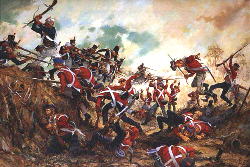


Had the British advance guard of 1,600 troops pushed forward with determination along it's left bank on 23 December for the last seven miles New Orleans could have been taken because Major-General Andrew Jackson had not set up any defences yet.
By the time that Major-General Sir Edward Pakenham caught up with the British troops he had been sent to command the American troops and local negro slaves had built defences.
The defences were elaborate, a breastwork of sugar barrels and earth behind a wide empty ditch, which stretched between the river and an impassable swamp. The American commander placed most of his men behind these defences, with four guns and a battery on the right providing support fire.
The British commander was now in a difficult situation, the heavy guns brought from the British ships were unable to breach the American breastworks. Instead of giving up and leaving he decided to make a strong feint against the American position. He had 6,000 British regulars and about 1,000 negros from the West India Regiment.
On January 8th 1815, Colonel William Thornton crossed the river with 1,500 regulars and moved up the west side to outflank the American position. Thornton's men did push away 800 Kentucky militia and sieze the naval guns, and advanced far enough up river to be behind the American position. But they were way behind schedule, and an attack by the rest of the British army had met with disaster. The British columns were hammered by American artillery as they tried to move through a ditch made muddy by a recent rain.
Major-General Sir Edward Pakenham was killed by a piece of grapeshot; Major-General Samuel Gibbs was mortally wounded and Major-General John Keane was seriously wounded. More than 2,000 British had been killed or wounded and several hundred more were captured. The American loss was eight killed and 13 wounded.
Jackson's victory had saved New Orleans, the Battle however is fought after the official treaty is signed in Paris. News is too slow in reaching the opposing armies to tell them it is over. The accidental linking of the peace treaty with Jackson's victory at New Orleans convinced many Americans that the war had ended in triumph. The Hartford Convention was discredited, and a surging nationalism swept the country in the postwar years. By the end of the century, many American children have never heard of the War of 1812. By the 1960's, it is reduced to a folk song, the song is entitled "The Battle of New Orleans" it was written by a man named Jimmy Driftwood. The song was recorded and made famous in 1959 by Johny Horton.